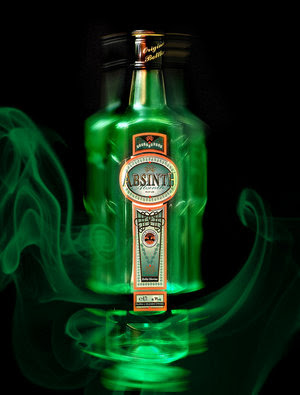
Presenting the 80% alcohol Absinthe

Then the 70% Absinthe

and the 60% Absinthe

Absinthe is one of those mysterious beverages that combines a certain mystique with a sense of wonder. Throughout its storied history, even absinthe connoisseurs have wondered at the mysteriously seductive powers of the "Green Fairy." Long popular with late 19th and early 20th century French Impressionist artists and writers, the seemingly psychedelic abilities inspired by the alcoholic beverage aroused curiosity in even the most conservative sampler.
In its purest form, absinthe is a powerful herbal liqueur. The invention of the "Green Fairy" is most commonly attributed to France's Dr. Pierre Ordinaire in 1792. However, most experts believe Ordinaire was a physician who romanticized about the herbal tonic's healing capabilities and capitalized on the possibility of absinthe's commercial use.
The earliest references to absinthe derivatives are attributed to two Herriod sisters in the Neuchatel region of France as far back as the 1750's. Regardless of the "Green Fairy's" origins, the French made the drink famous when the Pernod Fills Absinthe Company was founded in 1805 in the village of Pontarlier in the quiet Doubs region of rural France near the foothills of the Jura Mountains. Absinthe was also produced near Couvet in Switzerland, but it was the French who embraced the bitter herbal beverage and undertook active distilling.
The first absinthe distillery was run by Henri-Louis Pernod who oversaw the manufacture of the company's two stills. Pernod Fills Absinthe produced about 16 liters of Absinthe per day in those early years. The limited quantities did nothing to decrease the mystique associated with the liqueur.
By the early 1800's Absinthe Alcohol fast became one of Europe's favorite drinks. France dubbed the herbal liqueur La fee verte or the Green Fairy. As the popularity of absinthe grew, so did Pernod Fills' ability to produce the drink. Henri-Louis Pernod's son, Louis purchased 36,000 square meters of land alongside the Doubs River and constructed a factory capable of manufacturing 400 liters per day. At the time of his death, his successors Fritz and Louis-Alfred Pernod operated 26 stills and produced 20,000 liters of absinthe per day.
The Pernod boys were financed by the Veil-Picard Swiss banking family and by the famous Swiss engineer, Arthur Borel. Borel was responsible for innovative distilling methods and for creating the effective bottling and packaging equipment that allowed for bulk distribution of the alcohol throughout Europe. The Pernod-Borel combination was a good one. Pernod Fills soon became one of France's most successful companies.
As successful as the company was, one of their more remarkable accomplishments was their enlightened approach to women's rights. The company relied heavily upon its female employees and Pernod Fills responded by treating the women humanely, providing insurance against accidents and even developing a profit sharing and pension system as early as 1873.
As a strong herbal liqueur, absinthe is distilled with many flavorful herbs including anise, veronica, fennel, lemon balm, angelica, licorice, hyssop, Florence Melissa, and Roman wormwood. The modern absinthe has a distinctive flavor of anise or licorice. Other variations may use angelica root, sweet flag, dittany leaves, coriander or other mountain herbs.
In the early 1900's, absinthe, in its original form, was banned by Switzerland and France. The original herbal liqueur is still banned in the U.S. The culprit is wormwood or Thujone. It was believed that absinthe was so powerful that not only did it unleash the creative juices but also it became addictive with disturbing side effects.
Absinthe is marketed over the counter in the U.S. but not in the original form. Most of Europe has lifted bans against the variations of the beverage. Today, absinthe is most commonly used as a mixer for classic cocktail recipes. This is a far cry from portrayals of absinthe imbibers by Degas, Picasso, Van Gogh and Toulouse-Lautrec, who revealed disillusioned patrons overcome with absinthe. Perhaps the closest commercial grade absinthe is Absente, which has developed a balance that neutralizes the licorice flavor.
The "Green Fairy" bears a lot of history and a lot of romance. With each sip, the herbal liqueur takes you back to a different time and a different place and that is just part of the mystique.
Green Devil provides information, tips and kits on the making and history of absinthe throughout the ages. Learn more about the allure this beverage has held over the centuries or make your own absinthe alcohol and find out for yourself. Visit online at http://www.greendevil.com/ for more information.
Well who cares anyway =.=''. People just careless bout history anymore..... Anyway enjoy ur next absinthe and kill off ur beautiful liver and braincells if u may wish to b =) .
.jpg)
0 comments:
Post a Comment